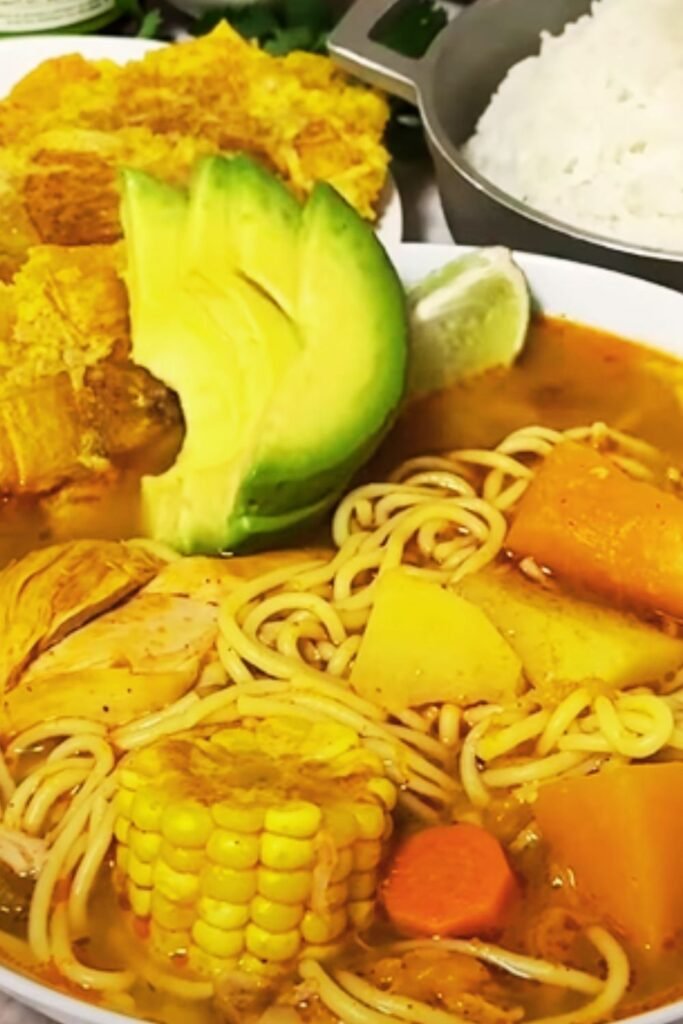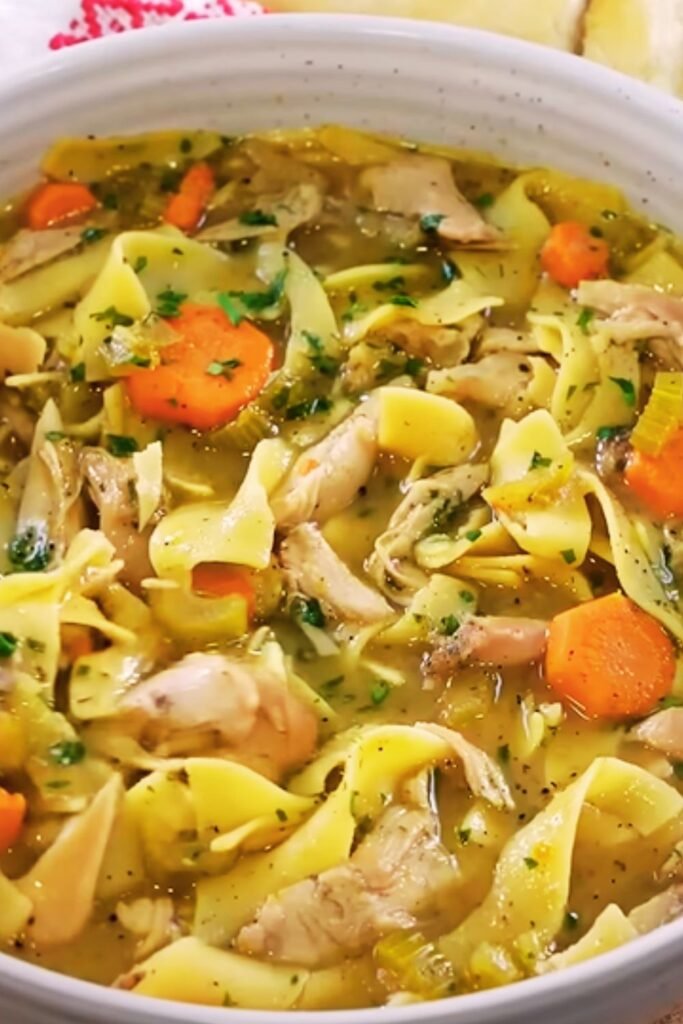Winter evenings call for something special, and nothing quite compares to the soul-warming embrace of homemade chicken noodle soup. I’ve been perfecting this recipe for years, and I can honestly say it’s become my go-to comfort food when the temperature drops and my family needs something hearty and nourishing.
There’s something magical about the way a steaming bowl of chicken noodle soup can transform even the gloomiest winter day. The rich, golden broth, tender chunks of chicken, perfectly cooked vegetables, and slurp-worthy noodles create a symphony of flavors that speaks directly to the heart. This isn’t just any ordinary soup recipe – it’s my carefully crafted version that combines traditional techniques with a few personal touches that make all the difference.
Understanding the Perfect Chicken Noodle Soup
Comfort Food Foundation : The cornerstone of exceptional chicken noodle soup lies in building layers of flavor from the ground up, starting with quality ingredients and proper technique.
Broth Quality : A rich, flavorful broth serves as the soul of the soup, requiring time, patience, and the right combination of bones, vegetables, and seasonings.
Texture Balance : The ideal soup achieves harmony between tender chicken, al dente noodles, and perfectly cooked vegetables that maintain their integrity without becoming mushy.
Aromatic Profile : The perfect blend of herbs and aromatics creates that distinctive, comforting scent that fills your kitchen and makes everyone gather around the table.
Essential Ingredients for Winter Warmth
Creating the perfect chicken noodle soup requires careful selection of ingredients. I’ve learned that each component plays a crucial role in developing the final flavor profile, and there’s no room for shortcuts when you’re aiming for perfection.
Primary Ingredients
| Component | Quantity | Purpose | Selection Tips |
|---|---|---|---|
| Whole Chicken | 3-4 lbs | Base protein and broth foundation | Choose free-range for better flavor |
| Wide Egg Noodles | 12 oz | Main carbohydrate component | Avoid thin noodles that break apart |
| Yellow Onions | 2 large | Aromatic base and sweetness | Look for firm, unblemished bulbs |
| Carrots | 4 large | Natural sweetness and color | Choose thick, straight carrots |
| Celery Stalks | 4 stalks | Classic flavor trio completion | Include leaves for extra flavor |
| Garlic Cloves | 6 cloves | Depth and aromatic complexity | Fresh cloves only, never powdered |
| Bay Leaves | 3 leaves | Herbal backbone | Turkish bay leaves work best |
| Fresh Thyme | 2 tablespoons | Earthy, comforting notes | Fresh herbs make all the difference |
Supporting Cast of Flavors
The magic really happens when you layer in the supporting ingredients that elevate this soup from good to extraordinary. I’ve discovered that using fresh parsley, quality chicken stock as a backup, and the right seasonings makes an incredible difference in the final result.
Fresh Herbs : Parsley, thyme, and dill create a garden-fresh brightness that cuts through the richness of the broth.
Aromatics : Beyond the holy trinity of onions, carrots, and celery, adding leeks and fresh ginger brings unexpected depth.
Seasoning Elements : Kosher salt, fresh cracked black pepper, and a touch of white pepper create the perfect seasoning foundation.

The Art of Building Flavor
My approach to chicken noodle soup centers around building layers of flavor at every step. This isn’t a dump-and-go recipe – it requires attention and care, but the results are absolutely worth the effort.
Step-by-Step Cooking Process
Initial Preparation Phase
- Pat the whole chicken completely dry and season generously with salt and pepper
- Dice the onions into uniform pieces, roughly ½-inch squares
- Cut carrots into diagonal slices, about ¼-inch thick
- Slice celery stalks, including some leaves for extra flavor
- Mince garlic cloves finely to release maximum flavor
Broth Development Stage
- Place the seasoned chicken in a large, heavy-bottomed pot
- Cover with cold water by about 2 inches
- Add one quartered onion, 2 celery stalks, 2 carrots, and bay leaves
- Bring to a gentle simmer, never a rolling boil
- Skim foam regularly for the first 30 minutes
- Simmer for 1.5 to 2 hours until chicken is fall-off-the-bone tender
Vegetable and Noodle Integration
- Remove chicken carefully and set aside to cool
- Strain the broth through a fine-mesh strainer
- Return clear broth to the pot and bring back to a simmer
- Add prepared vegetables in stages based on cooking times
- Cook noodles separately to prevent mushiness
Temperature and Timing Mastery
| Cooking Stage | Temperature | Duration | Key Indicators |
|---|---|---|---|
| Initial Simmer | Medium-low | 15 minutes | Gentle bubbling, foam formation |
| Main Cooking | Low simmer | 90-120 minutes | Chicken easily shreds, rich color |
| Vegetable Addition | Medium | 8-10 minutes | Carrots tender-crisp |
| Final Assembly | Medium-low | 5-7 minutes | All elements heated through |
Professional Techniques for Home Cooks
Over the years, I’ve picked up several professional techniques that dramatically improve the quality of homemade chicken noodle soup. These aren’t complicated methods, but they make a substantial difference in the final product.
Broth Clarification Method
The secret to crystal-clear, restaurant-quality broth lies in proper temperature control and skimming technique. I never let my broth come to a rolling boil because it emulsifies the fat and creates a cloudy appearance. Instead, I maintain a gentle simmer where bubbles just barely break the surface.
Fat Removal Technique : After straining the broth, I let it cool slightly and use a ladle to remove surface fat, or better yet, refrigerate overnight and lift off the solidified fat layer.
Seasoning Balance : I taste and adjust seasoning multiple times throughout the cooking process, remembering that flavors concentrate as liquid reduces.
Texture Preservation : Cooking noodles separately prevents them from absorbing too much broth and becoming mushy, while also keeping the soup from becoming too thick.

Customization and Variations
One of the beautiful aspects of chicken noodle soup is its adaptability. I’ve experimented with countless variations over the years, and each one brings something unique to the table while maintaining that essential comfort food appeal.
Regional Style Adaptations
Pennsylvania Dutch Style
- Add square egg noodles instead of traditional shapes
- Include a splash of cream in the final minutes
- Use more black pepper for a distinctive bite
Asian-Inspired Variation
- Incorporate fresh ginger and garlic
- Add bok choy and shiitake mushrooms
- Finish with sesame oil and green onions
Mediterranean Touch
- Include diced tomatoes and fresh basil
- Add white beans for extra protein
- Finish with a drizzle of good olive oil
Dietary Modification Options
| Dietary Need | Modification | Flavor Impact | Cooking Adjustment |
|---|---|---|---|
| Gluten-Free | Rice noodles or quinoa | Slightly different texture | Cook separately, shorter time |
| Low-Sodium | Reduce salt, increase herbs | More herb-forward | Taste frequently |
| Dairy-Free | Skip cream additions | Cleaner, brighter flavor | No timing changes |
| Protein-Boost | Add beans or lentils | Heartier, more filling | Extend cooking time |
Serving Suggestions and Presentation
The way you serve chicken noodle soup can elevate the entire dining experience. I’ve learned that presentation matters, even for comfort food, and a few simple touches can make your homemade soup feel special and restaurant-worthy.
Accompaniment Recommendations
Bread Pairings
- Crusty sourdough rolls with butter
- Homemade biscuits with honey
- Grilled cheese sandwich triangles
- Artisanal crackers with herbs
Side Dish Harmony
- Simple green salad with vinaigrette
- Roasted winter vegetables
- Steamed broccoli with lemon
- Fresh fruit salad for contrast
Garnish Ideas
- Fresh chopped parsley for color
- Cracked black pepper on top
- A drizzle of extra virgin olive oil
- Freshly grated Parmesan cheese

Storage and Meal Planning
Understanding proper storage techniques ensures you can enjoy your homemade chicken noodle soup for days to come. I’ve developed a system that maintains quality and makes reheating simple and effective.
Refrigeration Guidelines
Short-Term Storage (3-4 days)
- Store soup and noodles separately when possible
- Use airtight containers to prevent flavor absorption
- Cool completely before refrigerating
- Label with date for food safety
Reheating Best Practices
- Warm gently over medium-low heat
- Add fresh broth if needed to restore consistency
- Taste and adjust seasoning after reheating
- Don’t boil during reheating to preserve texture
Freezing Instructions
| Component | Freezer Life | Preparation Method | Thawing Instructions |
|---|---|---|---|
| Broth Only | 6 months | Cool completely, leave headspace | Thaw overnight, reheat gently |
| Soup with Vegetables | 3 months | Package in meal-sized portions | Thaw in refrigerator 24 hours |
| Cooked Chicken | 4 months | Shred and package separately | Thaw and add to fresh soup |
Troubleshooting Common Issues
Even experienced cooks encounter challenges when making chicken noodle soup. I’ve dealt with virtually every problem you might face, and I’m happy to share solutions that have worked consistently for me.
Flavor Problems and Solutions
Bland Broth Issues
- Increase simmering time for more concentration
- Add more aromatics like onion, celery, and herbs
- Season gradually throughout cooking, not just at the end
- Consider adding a splash of white wine for depth
Overly Salty Results
- Dilute with additional unsalted stock or water
- Add diced potatoes to absorb excess salt
- Balance with a touch of sugar or honey
- Serve over rice to distribute saltiness
Greasy Appearance
- Chill soup and remove solidified fat layer
- Use a fat separator during hot preparation
- Skim surface regularly during cooking
- Choose leaner chicken parts initially
Texture Troubleshooting
Mushy Noodles
- Cook noodles separately and add just before serving
- Use thicker, more robust noodle shapes
- Reduce cooking time by 1-2 minutes from package directions
- Store leftover noodles separately from broth
Vegetables Too Soft
- Add vegetables in stages based on cooking times
- Cut vegetables slightly larger than desired final size
- Remove from heat while still slightly firm
- Consider blanching vegetables separately first
Health Benefits and Nutritional Value
Chicken noodle soup isn’t just comfort food – it’s genuinely nutritious and offers several health benefits that make it perfect for winter wellness. I’ve always believed that the best comfort foods are those that nourish both body and soul.
Nutritional Breakdown
| Nutrient Category | Benefits | Primary Sources in Recipe |
|---|---|---|
| Protein | Muscle maintenance, immune support | Chicken, egg noodles |
| Vitamins | Immune system, energy metabolism | Carrots (Vitamin A), herbs (Vitamin C) |
| Minerals | Bone health, electrolyte balance | Chicken broth, vegetables |
| Fiber | Digestive health, satiety | Vegetables, whole grain noodles |
Immune System Support
- High protein content supports antibody production
- Warm liquids help with hydration and congestion relief
- Garlic and onions provide natural antimicrobial compounds
- Steam from hot soup can help clear sinuses
Digestive Benefits
- Easy to digest when feeling unwell
- Warm liquids stimulate digestion
- Balanced macronutrients provide sustained energy
- Gentle on sensitive stomachs
Frequently Asked Questions
Q: How long should I simmer the chicken to get the most flavorful broth?
I recommend simmering the whole chicken for at least 90 minutes, but up to 2 hours for maximum flavor extraction. The chicken should be so tender that it practically falls off the bone when you try to remove it from the pot. Don’t rush this step – the long, slow simmer is what creates that rich, golden broth that makes restaurant-quality soup at home.
Q: Can I use rotisserie chicken instead of cooking a whole chicken?
Absolutely! Using rotisserie chicken is a great time-saver, though you’ll miss out on making your own rich broth. If you go this route, use high-quality chicken stock as your base and simmer it with aromatics for at least 30 minutes to develop flavor. Remove the skin from the rotisserie chicken and shred the meat, adding it during the last 10 minutes of cooking to prevent it from becoming tough.
Q: What’s the best way to prevent noodles from getting mushy in leftover soup?
The secret is cooking and storing the noodles separately from the soup. I always prepare extra broth and cook only the noodles I plan to serve immediately. For leftovers, I store the broth and vegetables in one container and any remaining cooked noodles in another. When reheating, I warm the broth first, then add the noodles just until heated through.
Q: How can I make my soup more filling without adding more noodles?
There are several ways to boost the heartiness of your soup. Try adding diced potatoes during the vegetable cooking stage, or stir in cooked white beans or chickpeas for extra protein and fiber. You can also add more carrots and celery, or include diced parsnips or turnips for additional substance and flavor complexity.
Q: Is it safe to leave soup simmering on the stove all day?
While it’s tempting to let soup simmer for hours, I don’t recommend leaving it unattended for extended periods. For food safety and energy efficiency, I suggest simmering for the recommended time, then transferring to a slow cooker if you want to keep it warm for serving throughout the day. Always maintain proper temperatures and never leave perishable foods in the “danger zone” between 40°F and 140°F.
Q: Can I make this soup in a slow cooker or Instant Pot?
Yes, both appliances work well with modifications. For a slow cooker, place the whole chicken and aromatics in the pot, cover with water, and cook on low for 6-8 hours. For an Instant Pot, use the soup function with a natural pressure release. However, you’ll still want to cook the noodles separately to maintain the best texture, regardless of which method you choose.
Q: What herbs work best if I don’t have fresh thyme available?
Fresh parsley is always my top substitute, offering bright flavor and beautiful color. Dried thyme works in a pinch – use about one-third the amount called for in fresh herbs. Other excellent alternatives include fresh dill, sage, or rosemary, though use rosemary sparingly as it can be overpowering. Fresh herbs added in the last few minutes of cooking provide the brightest flavor impact.
This chicken noodle soup recipe represents years of refinement and countless bowls shared with family and friends. The combination of homemade broth, perfectly cooked vegetables, tender chicken, and al dente noodles creates a bowl of comfort that’s hard to beat. Whether you’re fighting off winter chills, recovering from illness, or simply craving something warm and satisfying, this soup delivers every time. The key lies in taking your time with each step, using quality ingredients, and cooking with love – because that’s what transforms a simple soup into true comfort food.